Auschwitz Journal |
Notes from my trip in October 2005 |
|
In October 2005, I made my second trip to Poland. I had previously visited Poland in October 1998 and toured many of the former death camps, including Auschwitz-Birkenau. Since I can't speak a word of Polish, I had arranged my 1998 trip in advance, through Orbis Polish Travel Bureau. When I decided to visit Auschwitz-Birkenau again in 2005, I planned to go entirely on my own, without a guide. I selected the first week in October as the ideal time to visit Auschwitz for the second time. Summer vacation would be over and the crowds would be gone. I made sure that there was no special event, nor any Jewish holiday, during that week which would mean large groups of people visiting the camp. When I visited Auschwitz-Birkenau in October 1998, there were virtually no tourists there, only a couple of groups of Polish students. At the main camp, there were only one or two tour buses in the parking lot. The Birkenau camp was completely deserted when I visited in October 1998. I was all alone in the camp with my private tour guide. It was so sad and depressing that I cut short my visit to Birkenau and didn't take very many photographs. The photo below, taken from the tower in the gate house at Birkenau in October 2005, shows the tour buses and taxi cabs parked at the former Birkenau camp. This picture was taken in the early morning before the crowds arrived.  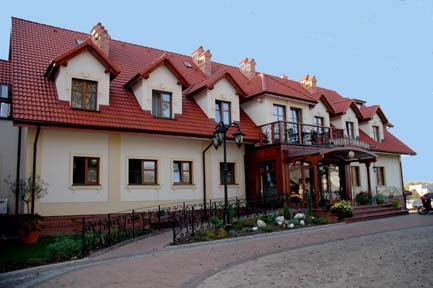 Yes, I stayed in a hotel in the town of Auschwitz. I know that this sounds horrible, but Auschwitz is not as bad as one might think. It is a relatively modern town of 50,000 inhabitants; the main part of the town is across the Sola river from the former death camp, which is now the Auschwitz Museum. I stayed at a charming hotel called the Hotel Galicja, which is located in a building that was formerly an old post office. The building has been completely remodeled inside. The staff there was super nice; everyone speaks English and they are very friendly and accommodating. The hotel is located at 19 Dabrowshiego, 32-600 Oswiecim. Dabrowshiego street, named after a Polish general, is the main thoroughfare through the town of Auschwitz. The hotel is a long way from the Auschwitz Museum, and a taxi ride to the former camp costs anywhere from 14 zloty to 30 zloty, depending on the driver. E-mail the Hotel Galicja at Galicja@hotel galicja.com.pl 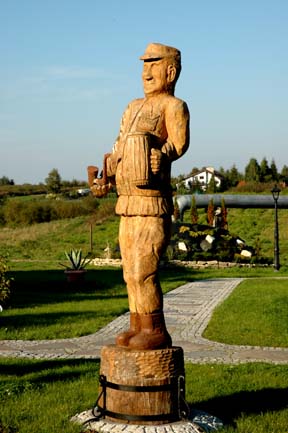 When I visited Auschwitz in 1998, there was only one hotel - the Glob hotel. That is not a typo; the name of the Hotel is Glob, even though it is called the Globe hotel on some web sites. The Glob is located right next to the train station in Auschwitz, making it very convenient for those who choose to go by train. This hotel is also convenient to the Birkenau camp, close enough to walk. The building is modern, designed in the typical post-war Communist architectural style. I don't know what it is like inside, but I don't think it can compare with the Hotel Galicja, which is fantastic. I stayed at the Cracovia Hotel in Krakow in 1998 and took a taxi to the camp on two successive days. On my 1998 trip, I flew to Warsaw, where my Orbis guide met me at the airport and drove me to my hotel. At that time, I didn't know that there was an international airport in Krakow and that the airport is actually closer to Auschwitz than the city of Krakow is. In October 2005, I flew to Krakow and the Hotel Galicja sent a taxi driver to pick me up at the airport. It took about an hour to drive from the airport to my hotel but the cost was only 170 PLN or the equivalent of about $57 American dollars. To get to Auschwitz from the Krakow airport, the driver took Road 780 and then turned on Road 44. On the way, we passed a place called the Texas Pub. My taxi driver told me that people in Poland watch American TV shows and they are very familiar with American culture. On the old town square in Auschwitz, there is another place called the Indiana pub. We came into the town of Auschwitz from the east and I immediately saw a six-foot-high wall with fence posts that looked like the curved concrete fence posts in the former Auschwitz and Birkenau camps. Behind the wall were large factory buildings. I learned later that these were the old factories of the Monowitz labor camp, built by the prisoners sixty years ago. Some of the buildings have been abandoned, but there are still factories in operation in some of the original buildings. The town of Auschwitz seems to have expanded toward the east, in the direction away from the former death camp, as though to escape from the past. There are new high-rise apartment buildings with balconies where clothes are hung up to dry. There are modern stores in strip malls. The old town square is no longer used for an outdoor market. Instead, there is a large space on Dabrowshiego street, very near the Hotel Galicja, where there is an open air market. On the way to the hotel, the taxi driver pointed out a homeless shelter, a hospital, a large indoor swimming pool, the blue and white building of the Dwory factory where 5,000 people now work, and a large ice hockey rink. Time marches on, and Auschwitz is now noted for sports, not death and destruction. Directly across the street from the ice rink, there is a monument to the victims who died at Monowitz. The driver did not point it out to me, but instead told me all about the Auschwitz ice hockey team. I learned later that there is a village, still in existence, called Monowitz which is about 4 kilometers from where the factories are located. All of the Monowitz barracks have long since been torn down and there are now houses where the prisoners once lived. Just before we arrived at the hotel, the taxi driver pointed out the bus station which is within walking distance. For visitors coming from the city of Krakow, the bus is more convenient than the train for those staying at the Hotel Galicja. On my first day at Auschwitz in 2005, I arrived by taxi at the main camp at 8:10 a.m. I was astonished to find that there were 3 tour groups ahead of me already in the camp. Each group of about 50 people had a guide who would give a 15 minute speech at each point of interest, while other tour groups waited their turn. There was only a few seconds between each group to snap a picture. On that first day, I decided to take a short cut to the Krema I gas chamber to get ahead of the crowd. I did manage to get some time alone there and was able to take several photographs. Everything seemed smaller to me on my second trip. The gas chamber looked smaller and the Birkenau camp looked smaller than I remembered it. One thing that I hadn't noticed before is the names on the wall of the Visitor's Center. I was appalled that anyone would desecrate this building with graffiti, as shown in the photo below. 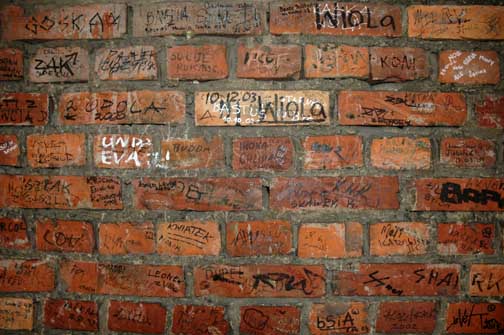 In the Museum buildings at the main camp, the tour groups shuffled along, inching their way past the glass exhibit cases. I have never seen such crowds of people at any historical site. The word Disneyland comes to mind. It was impossible to pause and reflect on the suffering of the owners of the shoes and the suitcases on display. A group of German students stopped in front of the display case of wooden legs while their leader spoke for at least 20 minutes. I noticed that all the German students were very respectful, while the Polish students were a bit rowdy, laughing and talking as they waited their turn at the exhibits. 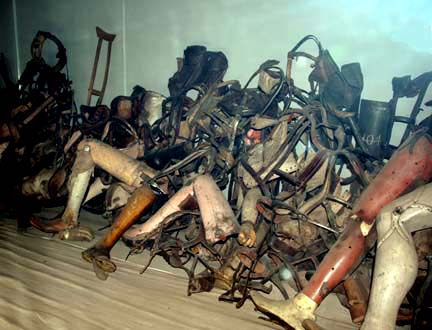 There are signs all over the Auschwitz-Birkenau camps, asking people to be quiet and to think of the victims who died there. In spite of this, it seemed to me that no one looked sad or upset; it was more of a party atmosphere. There was a huge crowd of people at the Black Wall, filling almost the whole courtyard between Block 10 and Block 11. In the basement of Block 11, it was impossible to see the prison cells because it was so crowded. There was very little air in the basement and I had to breathe deeply to keep from fainting. Fortunately, I had seen all of this in 1998, when I was the only one there and could spend as much time as I wanted. I did manage to hold up the crowd of people for about a minute while I put my camera lens through the bars of one of the cells and snapped a photo. In the tower of the gate house at Birkenau, I waited while a guide addressed a group of Polish students for about 20 minutes. At the end of her speech, the students applauded. I know that this was intended to be a compliment to the guide who was able to speak at length about history without notes, but it was a shock to me, nevertheless. It was as though they were applauding what happened at the Birkenau death factory sixty years ago. At 11 a.m. on my first day at Auschwitz, I went to the movie theater in the Visitor's Center and saw the film made by the Soviet Union when the camp was liberated. This was the English version of the movie and there were enough English speakers to fill the theater. Most of the people in the audience looked like Americans. In 1998, most of the audience consisted of Polish students, since I was the only American there. The photo below, which is one of my favorite pictures, is a still shot from the movie. The two women in the center, wearing striped prison uniforms were identified by name. Apparently, they were leading Communist political prisoners and the Soviet liberators paid special attention to them. The woman who is smiling is named Olga, but I didn't catch the last name. I like this photo because it shows soldiers of the Soviet Union being very kind and helpful, not the way they have been portrayed in some accounts of World War II.  With the large crowds of people at Auschwitz, there is now a problem with thieves. In the Visitor's Center, there was a sign warning tourists to watch out for pick-pockets. On my 1998 trip, I did not notice any police officers at Auschwitz. This time, there were a few uniformed officers at each of the camps. In 2005, there were shuttle buses that ran between the Auschwitz main camp and the Birkenau camp every half hour. The trip took about 5 minutes. The bus stop at Birkenau is in the parking lot to the left of the gate house where all the tour buses park. The shuttle bus is free. There is also a city bus that makes frequent stops at Birkenau. You can catch this bus at the train station. The Birkenau camp closed at 5:00 p.m. in October. In the Summer, the camps are open later and the buses run until closing time. At Birkenau, there are benches in front of the gate house where you can wait, and there is a small bookstore with chairs and benches. 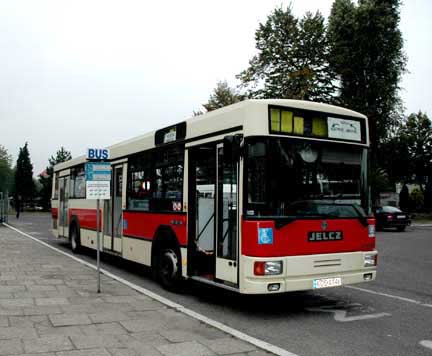 There is a room for "left luggage" at the main Auschwitz camp. I left my backpack, full of the books that I had purchased, when I went on the shuttle bus to Birkenau, only taking my camera with me. I wanted to travel light because it is a long walk around the Birkenau camp. There was no place to eat at the Birkenau camp in 2005. The book store had a few candy bars and one could buy a very small cup of coffee or hot chocolate from a vending machine there, but that's all. I scheduled my time each day so that I could always eat lunch at the main camp. There is a small snack stand near the entrance to the parking lot at the main camp where you can buy a "hot dog." Inside the Visitor's Center, there is a snack bar where you can buy cookies, peanuts, cokes, candy bars, pizza, etc. There are tables and chairs nearby where you can eat. Across the street from the Visitor's Center, there is a Polish restaurant. If you want to place flowers at the Black Wall or the International Monument at Birkenau, you can buy them from a small store at the main camp. There is also a book store where you can choose from a wide selection of books and postcards. The tour groups do not visit some areas of the Birkenau camp, so I was all alone for some time there. Fortunately, nothing bad happened to me, and I had no problem finding everything on my own, with the aid of a map which I purchased from a taxi driver on the way there. On my second day there in October 2005, I went to Birkenau first. I got there at 8 a.m. and went first to the barracks buildings which I had not been able to see the day before because of the crowds of people. There were two British photographers there, taking some serious pictures for a documentary. From there, I walked to the end of the camp, where the International Monument is located. As I walked along the road, a small cart that looked something like a golf cart passed me. There were four women riding in the cart, stopping frequently to pick up the garbage left by visitors the day before. I thought about asking them for a ride to the end of the camp, which is about a mile from the entrance, but I didn't. It occurred to me that the camp should provide carts for older visitors. A trip around the whole Birkenau camp is about 4 miles. At the International Monument, I was horrified to see that the clean-up crew removed most of the flowers and the votive candles, placed there only the day before. I suppose that this is necessary because each day a new crowd of tourists arrives to place more flowers and candles. With over 1.3 million tourists visiting Auschwitz-Birkenau in 2009, there must have been a lot of flowers left there. Behind the International Monument is a road that leads to the ruins of Krema IV and Krema V and the Sauna where there is an exhibit of photographs that were found in the camp. The tour groups did not go down this road. They returned, along the main road, to the gate house at the entrance. I was all alone in this area on two different days. It is hard to imagine the horror that took place here, because it is such a pleasant place now. There are benches where one can rest at the halfway point along this road. There are also toilets across the road from the benches. This is the location of the the birch tree grove, where the Hungarian Jews had to wait for their turn in the gas chambers in 1944. (Birkenau means birch tree meadow in German.) The remains of the little white house, known as Bunker 2, are just west of the Sauna. Bunker 2 had four small gas chambers, no larger than 8 feet by 8 feet, that had to be put into service again in 1944 for the gassing of the Hungarian Jews, since the four gas chambers at Birkenau could not handle such large numbers of people. I found the remains of Bunker 2 by accident when I continued walking north along the road at the west end of the camp, instead of following the arrow at the benches which directs visitors to take a road that goes east to the Sauna building. The road curves back around to the Sauna building after passing the little white house. Each day, I took a taxi cab from my hotel to either the main camp or Birkenau. At the end of the day, there were taxi cabs waiting outside the entrance at each of the camps. On one of my trips, my driver was a man named Jan Gut. He was very friendly and eager to point out the sights to me. As we drove away from the main camp, he showed me the house where Rudolf Hoess, the first Commandant of Auschwitz, formerly lived. The back of the house is inside the Auschwitz I camp, but the front door faces a busy street. He stopped the cab so I could take the photo below.  I was amazed to see that two families now live in this house and both have a satellite dish for TV reception. Hoess was the greatest mass murderer of all time; he was responsible for the deaths of at least a million Jews, although he confessed to killing 3 million. How could anyone live in this house! On Sunday afternoon I took a taxi directly to the former SS headquarters in Birkenau, which is now a Catholic Church. I was standing there when Jan Gut drove up and asked me if I wanted to see the Judenrampe, where the Jews disembarked from the trains before the tracks were extended into the camp, right up to the gas chambers. I took him up on the offer to take me on a tour and we drove to the railroad siding known as the Judenrampe or Jews ramp. He told me that there was no train station at this spot, only a wooden ramp where the Jews got off the train. In 1942, the four gas chambers at Birkenau had not yet been put into operation, but 70 to 75% of the arriving Jews were taken by truck to Bunker 1 and Bunker 2, where they were immediately gassed and their bodies buried in a mass grave, as there were no cremation ovens at that time. Across the road from the Judenrampe, there is a long row of old abandoned commercial buildings that are now in ruins and covered with graffiti; the only time I was worried about being attacked or robbed while I was in Poland was when I was walking along this road all alone, while I waited for my taxi driver to come back and pick me up, after driving another passenger to some other location. These old buildings look like the perfect place for a gang of thieves to hang out, but there was no one there and nothing happened to me. 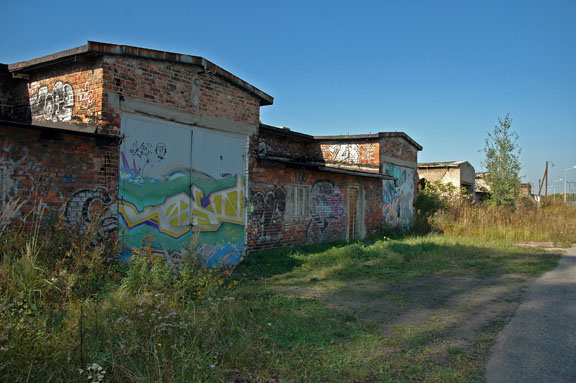 After visiting the Judenrampe, Jan Gut drove me to see what is left of Monowitz. He told me that when he was six years old, the Monowitz factories were bombed at least three times. He showed me the bomb shelter used by the SS at Monowitz, which is still standing. He also told me that the Germans had built good roads to the Monowitz factories, which was fortunate because Auschwitz continued to be a factory town after the war. Several times, Jan Gut brought up the subject of the Carmelite nuns who were forced to move out of a building in the Auschwitz I camp that originally housed a theater. A new building was constructed for them across the street and the beautiful building where the nuns lived from 1984 to 1993 is now empty. Jan explained to me that Rabbi Weiss in New York City had led the protest that resulted in the nuns being removed from this historic building where the Nazis had stored the Zyklon-B used to gas the Jews. The Polish people are still unhappy about their sovereign nation being told what to do by someone residing in another country.  For a private tour of the town of Auschwitz, I recommend Jan Gut who can be contacted by e-mail at this address: kuper-gut@hot.pl Jan speaks English very well and drives an American mini van that can carry 6 passengers. When I visited Poland in October 1998, there was a big controversy about the Christian crosses that had been put up near the theater building shown above. I went back to see this spot and it was now peaceful. The only cross there now is the one used by Pope John Paul II on the historic occasion in 1979 when he said mass for a crowd of 500,000 people at Birkenau. The cross is shown in the photo below; in the background is Block 11, the prison block at the Auschwitz main camp. The cross stands in a former gravel pit where 152 Polish political prisoners were executed by the Nazis. The theater building is to the left, but out of camera range. From inside the Auschwitz camp, this cross cannot be seen. In front of the building, you can see the light colored stone wall around the camp. 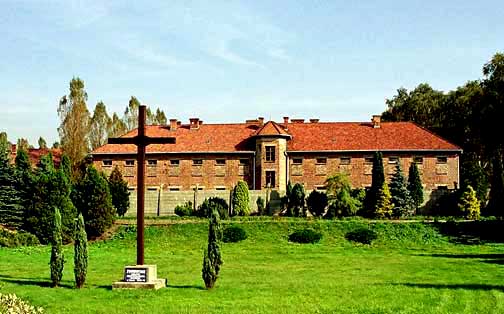 On my trip in October 2005, I planned to spend some time visiting the town of Auschwitz, which is called Oswiecim by the Poles. I took a taxi to the restored Jewish Synagogue on Sunday morning, arriving shortly after it opened at 8:30 a.m. I was the only person there. The Synagogue is located only a stone's throw from the Catholic Church, so it is easy to find. There is a small square in front of it, formerly called Church Square, which is now the parking lot for the church. An old photograph shows that this was the former location of a well where the Jews came to get water. There were many Polish towns that did not have running water before World War II. In 1939, just before Germany invaded Poland, Oswiecim had a population of 12,000 people, and 7,000 of them were Jews. Of the 5,000 non-Jews, the largest ethnic group was the Gypsies. Today, there are 200 Gypsies living in the town, but not a single Jew. The days of the Jews in Poland are "gone with the wind." There are no more shtetls, no more Jewish quarters, no more Jewish ghettos in the cities. The few Synagogues that are left are now shown to non-Jewish tourists by non-Jewish caretakers. I did not see anyone that I could identify as Jewish, either in the town or in the crowd of visitors at the Auschwitz-Birkenau camps. On my last day in Poland, I visited the former Jewish ghetto called Kazimierz in the city of Krakow. When I was there in 1998, I was the only tourist, and I had the whole place to myself. I planned my 2005 trip so that I would be visiting Kazimierz on a Monday, when it would not be crowded. I took a taxi from my hotel to Kazimierz. When the driver stopped, I was just getting ready to say "This isn't Kazimierz." when I noticed the Ariel restaurant. Other than that, the place was unrecognizable. The entire market square was filled with parked cars and there were little trains driving around the square while a taped recording played for the tourists. Some street construction was going on and one whole side of the square was torn up. At one end of the square was a booth with post cards for sale and at the other end, in front of a Synagogue, there was an antique pushcart filled with souvenirs for the tourists to buy. Inside the large Synagogue, there was an admission charge for visitors. In order to take photographs inside, a visitor has to pay an extra charge of 10 zloty. The interior of the Synagogue is stunning, as you can see in the photo below.  On one side of the square, all the buildings are now restaurants with tables outside filled with tourists. The former Jewish Bathhouse is now the Klezmer Hotel. The gate to the cemetery next to a famous Synagogue was open, and visitors were allowed to enter after paying an admission charge of 5 zloty. There was a lot of excavation activity going on. In the background of the photo below, you can see a white tent over an excavation site.  I was amazed at how Kazimierz has changed. It took me less than a minute to hail a cab on the market square and I left Kazimierz earlier than I had planned because it was so crowded. I went back to my hotel where I ordered room service and settled in for the night. The next day, I flew home to the good old USA. Notes from my trip in September 1998When I visited Auschwitz in September 1998, I had a private guide who drove me there from Krakow. As we approached the town of Auschwitz, the countryside reminded me of England. All the houses had lots of flowers in bloom. Then we reached the town of Auschwitz and the town looked like a town in Germany. That's because the town was built by German people in the year 1270. Back then, the Polish people welcomed the Germans because the Poles didn't know how to build cities or stone houses. The houses in Poland were built out of logs, and there are still many log houses on the road from Krakow to Auschwitz. The Germans built many of the Polish cities and cleared the land for agriculture. There is still a lot of land in Poland that has not been cleared and my guide told me that there is farm land that is not being used. Poland is a very large country with only 38 million people. After World War II, land was taken from Germany and given to Poland, including the land where Auschwitz is located, which was part of Greater Germany when Auschwitz was a concentration camp. However, the town of Auschwitz was dingy and run down when I was there in 1998. When Auschwitz was first opened as a concentration camp, the Germans cleaned up the town so that it would be suitable for the German engineers who set up factories in the area. My guide told me that Auschwitz is located in an area that has lots of coal so it was a prime location for factories. That is why Auschwitz was chosen as a location for a camp. On the way to the main camp, we passed some factories where the prisoners used to work and the guide told me that these factories were still in operation. When we got to the gate into the camp, I was astounded as we drove inside: There was a beautiful red brick building that looked like it had been built recently, but it was built in 1941. This was the administration building where the prisoners were registered. They had to take a shower and have their heads shaved so that they wouldn't get lice which spreads the disease called typhus. There were 17 "gas chambers" in this building, but they were used to kill the lice in the clothing so the prisoners wouldn't get typhus. The Germans used an insecticide called Zyklon-B to kill the lice and they used this same insecticide to gas the Jews in separate gas chambers. The camp parking lot was only about half full, with several tour buses. We went inside the administration building, which is now a tourist center. The place was crowded with 14-year-old Polish students who are required to visit Auschwitz. They were laughing and talking. One student pointed to a photograph on the wall in the Museum and jokingly said to me in English, "Look, there's my grandfather." My guide was horrified and told him to be quiet. However, all the other students around us had burst into laughter and my guide had a hard time getting them to be quiet. I was appalled. My guide was Jewish and she was dressed in black from head to toe. All the Jewish visitors were dressed in black, as though for a funeral. But the students were dressed in bright colors and they did not have a demeanor of respect. The first thing we did at Auschwitz was to see a movie. Most of the people in the theater were Polish students. I was amazed when I saw the photos taken by the Russians when they liberated the camp. There were photos of older women in their barracks and children walking out of the camp. The children all looked healthy and they had chubby cheeks. There were men in the camp who had double chins and two or three of the children were overweight. When we came out of the the theater, I got separated from my guide, because the students were pushing to get out of the door. It was like being at a rock concert. The students did not act appropriately for such a solemn place. By the time I found my guide, the students were ahead of us on the tour, so we had some peace and quiet. As we walked around the main camp, I was amazed at the buildings. These buildings were built in 1916 when this camp was first built for migrant laborers who stayed there while they were waiting to be sent to a new job working on the large estates in Germany. Auschwitz is the largest railroad center in Europe. All the train lines in Europe come to Auschwitz; that's why it was a good location for a camp. When Auschwitz was turned into a concentration camp in 1940, the Germans built a second story on these building. They did this so skillfully that you can't tell that the buildings were remodeled. They also built some new barrack buildings and these buildings are now apartment houses for Polish people and some are used by the Polish Army as barracks. One of the buildings where the prisoners lived at Auschwitz is now a hotel! So this gives you an idea that the living quarters were very nice in the main Auschwitz camp. When we were in the Museum, my guide kept talking constantly, explaining everything to me, so it was hard for me to feel sad because my concentration was broken by all the talking and the exuberant students. Some of the older Jewish visitors left the camp in protest and went back to their buses because they thought the visitors were being disrespectful. It was only when I visited Block 11, which was the prison block, that I finally broke down and cried. This is where the first gassing of people took place. Some Russian Prisoners of War were gassed in a room in the basement of Block 11. This room has a window. I asked my guide how they kept the prisoners from breaking this window and letting fresh air in; she told me that the Germans packed dirt against the window, so if it was broken, the dirt would keep the fresh air from going into the room. This seemed really strange to me because I know how clean the Germans are. As far as how the camp looked when the prisoners were there, it was just like it is now, according to the guide. We saw some rose bushes that were close to one of the buildings. I asked the guide if those roses were there when it was a concentration camp and she said that there were flowers in front of every building when it was a camp. Only a few roses survived. The roses were near the kitchen building. The guide told me that the camp orchestra used to play in front of this building. It is the first building you see when you go through the gate that says "Arbeit Macht Frei." The orchestra played every morning when the prisoners marched out to work in the factories and again at night when they came back to the camp. They always played classical music because Hitler had banned Jazz and swing music. "Arbeit Macht Frei" means Work Brings Freedom. This sign was only put on the camps that were Class I camps. The Class I camps were where prisoners were treated better than in the Class II and Class III camps. The Class II and III camps were for prisoners that were considered the worst enemies of the Germans. I had read somewhere that there was a swimming pool at Auschwitz and I asked the guide to show it to me. She told me that there were actually two swimming pools at Auschwitz, one for the prisoners and one for the SS guards. Then she quickly changed the subject and did not take me to see the pool. According to the tour guide, the prisoners swimming pool had been built when the camp was used as an Army base for Polish soldiers before Poland was conquered by the Germans in 1939. The last thing on the tour was the gas chamber in the main camp. This room was very creepy, but I was astounded to see that the main door into the chamber was an ordinary wooden door like a door into a house. It could have been easily broken. I was even more astounded to see that there was a back door in the gas chamber which had a glass panel. The guide said that a guard stood outside this door, ready to shoot anyone who broke the glass and tried to get out. I was amazed that the Germans were so stupid that they didn't replace that door; they probably had to put in a new window after each gassing. The guide said that the gas chamber was disguised as a shower room, but I couldn't see where any shower fixtures had been. The prisoners must have known that this wasn't a shower room because it is so huge. To sum up, the Auschwitz main camp was the most amazing sight I have ever seen. To think that people actually live inside the former camp and that people stay in one of the buildings that is now a hotel! I have read many books written by survivors of Auschwitz, but none of these books prepared me for what the Auschwitz main camp really looks like. After seeing the main camp, we drove back to Krakow. The guide would not take me to Birkenau, as that was a separate half-day tour which had to be done on a different day. The next day when I asked the guide to take me to Birkenau, she tried to talk me out of it. She told me "there is nothing to see there" and "no one goes there." I insisted and she finally agreed to arrange for a different guide to take me to Birkenau the following day. Back to Auschwitz Scrapbook home pageHome |